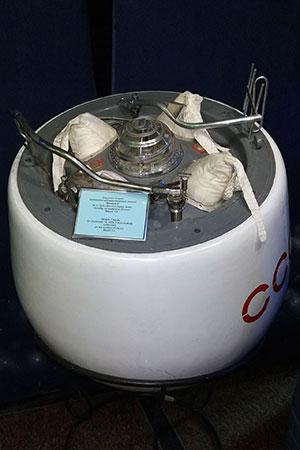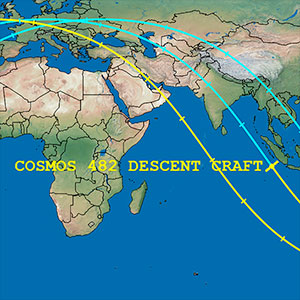May 10, 2025 — A capsule that was sent into space to land on a planet has finally done so — only on the wrong world and 53 years late.
The Kosmos 482 uncrewed spacecraft, which the former Soviet Union intended to touch down on Venus, instead returned to Earth on Saturday (May 10).
"The Kosmos 482 spacecraft, launched in 1972, ceased to exist, leaving orbit and falling into the Indian Ocean," Roscosmos, Russia's federal space agency, stated Saturday (May 10). "The spacecraft entered the dense layers of the atmosphere at 9:24 Moscow time [0624 GMT; 2:24 a.m. EDT], 560 km west of Middle Andaman Island, and fell into the Indian Ocean west of Jakarta."
The reentry, though uncontrolled, was not a surprise. Due to what is believed to have been an engine failure, Kosmos 482 never achieved the velocity needed to reach the second planet from the sun, resulting in it being stranded in a high, elliptical Earth orbit. It took more than half a century for gravity to pull the probe back in and on Saturday it arrived.
Unlike most spent space hardware that is destroyed in the process of falling back to Earth — including parts of the Molniya rocket that launched Kosmos 482 — the 3.3-foot-wide (1-meter) and 1,190-pound (495-kilogram) titanium-encased descent capsule was designed to survive a firery plunge into the atmosphere. As such, analysts tracking its approach predicted it could make it through the reentry intact.
Whether that happened or not is not known. Given that it came down in the ocean, there have yet to be any eyewitness reports or debris recoveries.
The Kosmos 382 capsule was also outfitted with a 27-square-foot (2.5-square-meter) parachute to slow its final approach to the Venusian surface. Either the deployment system did not work — as to be expected after more than 50 years in space — or, as some telescopic photos possibly showed, the chute was already out when Kosmos 482 encountered the atmosphere and burned up.
Had Kosmos 482 been successful, Russian officials would have renamed it "Venera 9" (not to be confused with the 1975 orbiter and lander that took on that designation and was the first spacecraft to circle Venus and first probe to send back images from the planet's surface). Kosmos 482 would have also been the third probe to land on the cloud-covered world.
Launched on March 31, 1972, four days after its successful twin, the Venera 8 probe, Kosmos 482 had sensors to measure the temperature, pressure and density of Venus' atmosphere, as well an accelerometer, radio altimeter, anemometer, gamma-ray spectrometer, gas analyzer, visible photometers and radio transmitters. All of its instruments were battery powered and had an expected lifespan of about 30 minutes on the surface (Venera 8 exceeded that, sending back data for 50 minutes before succumbing to the harsh conditions).
Since Kosmos 482's failure, seven more missions successfully landed on Venus, all of them launched by the former Soviet Union. The United States, Japan and the European Space Agency (ESA) also reached Venus, but only in orbit, on a fly-by or to receive a gravity assist on the way to another destination.
Had the Kosmos 482 descent capsule slammed down on land and it resulted in damage to either public or private property, Russia could have been held libel per the conditions of the United Nations' Outer Space Treaty of 1976. The same treaty would also allow Russia to retain ownership of the hardware, arranging for its collection, unless the country relinquished its claim to the human-made meteorite. |
|

A model of a Venera lander on public display in Russia. It is similar in design to the Kosmos 482 descent capsule that returned to Earth on Saturday, May 10, 2025. (Wikipedia/Emerezhko)

A ground track show the projected final orbits and location where Kosmos 482 was reported to reenter. (The Aerospace Corporation) |
